
Climate
WARM, SUNNY DAYS AND COLD NIGHTS DURING THE GRAPE RIPENING PERIOD
The climate in the wine region of Štajerska Slovenia is continental, with warm and hot summers and cold winters. The influence of the Alps, the Pannonian Plain, and partially the Adriatic Sea is strong. The climate becomes warmer as you move from west to east.
On average, between 900 and 1100 mm of precipitation falls annually, which is more than enough for the undisturbed growth of the vines. During the growing season, precipitation is well distributed. Drought is not usually a problem, except in very dry years in young vineyards on sandy soils. Snow falls every winter, although there has been considerably less of it in recent seasons compared to the past.



Frost is possible. Winter frost is very rare, but spring frost is becoming increasingly dangerous and common due to mild winters and earlier bud break. Hail occurs frequently, almost every year, but fortunately only affects a small part of the region.
In addition to the frequent mild winds throughout the year, sunny days and cold nights during the grape ripening period are crucial for the character of the wine, as they allow the acids and aromatic compounds formed during ripening to be excellently preserved. Morning fogs in September and October are favorable for the development of noble rot and the production of wines of exceptional quality. Temperatures can drop below freezing as early as November, which also allows for the production of ice wine.